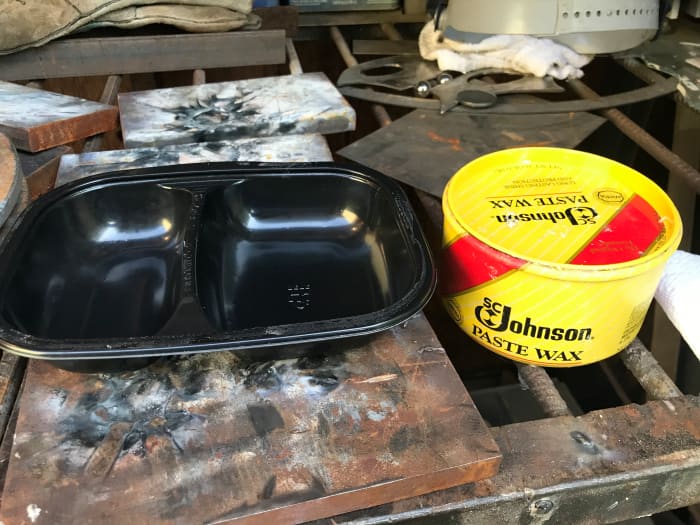How To Create A Fibreglass Mould
Exploring the nearly endless creative options available with plastics and resins.
How to Make Fiberglass and Resin Molds at Home
Fiberglass and casting resins are a rewarding creative medium, but they can be costly to use. This is especially true when you purchase specialized mold-making materials like silicone resin. Often these cost at least twice or more than the resin being used—not to mention that silicone is liable to tear under sheer force.
Most households have a plethora of discarded plastic containers and packaging materials that are chemically unreactive and possess smooth surfaces conducive to casting plastic and resin forms. Im this article, I will discuss using cleaned frozen dinner trays and packaging materials for resin molds.

Clean Frozen Dinner Tray and Johnson Paste Wax
Jason Bosh

Applying Paste Wax to Mold Cavity
Jason Bosh
Step 1: Prepare the Mold
You have your clean plastic tray and some paste wax. Take a bit of wax with a rag and apply liberally to the cavity you wish to use. Allow to dry a few minutes while gathering other supplies or preparing a pigmented fiberglass resin. When dry, use a clean cloth or towel to buff off the excess wax from mold cavity.

Waxed Mold
Jason Bosh

Applying A Coating of Pigmented Fiberglass Resin to Mold
Jason Bosh
Step 2: Wet the Mold Cavity
Now with your mold cavity fully waxed, it's ready for resin and fiberglass. Take some catalyze resin with a brush and dab it in. Make sure all surfaces are coated thoroughly. This preliminary application helps prevent air pockets from forming under the fiberglass cloth.

Applying Precut Fiberglass Cloth to Mold Cavity
Jason Bosh
Step 3: Apply Fiberglass Cloth to the Mold Cavity
After the first coating of catalyzed resin is laid down, it is time to lay down a precut piece of oversized fiberglass cloth.
Read More From Feltmagnet
Notice in the above picture that the cloth is already about half wetted out because of the preliminary treatment of the mold with resin. With a paint brush, you just tamp the cloth into place until all the surface of mold is covered.
Once in place, take the remaining portion of catalyzed resin and liberally apply to the cloth to saturate it. The cloth will appear "white" where is has not been thoroughly saturated. Fully wetting the cloth is where the strength of reinforced plastic comes from.

Addition of Remaining Resin to Fully Wet Fiberglass Cloth
Jason Bosh
Step 4: Cast With Filled Polyester Resin
The kind of polyester resin used for fiberglass is called laminating resin. Because it is applied in thin layers, more catalyst is added to provide heat for curing. For this reason, fiberglass laminating resin is not recommended for thick section casting. The excess heat buildup in a thicker portion of resin liable to crack or cause other issues.
One way to work around this is by using ample amounts of inert filler. In the photos below, I added cheap powdered calcium carbonate (limestone) until the resin had a pancake batter consistency. This filler absorbs the excess heat and also makes the casting process cheaper as well. If I didn't care for the beige color I could sand the fully cured casting with 220 grit wet or dry paper and apply a spray primer. Then it would be ready for most kinds of paint.

Laminating resin with calcium carbonate filler
Jason Bosh

Cured cast with calcium carbonate filled resin
Jason Bosh

Using Plastic Blister Packaging as a Mold for Casting Resin
Jason Bosh
Tips for Using Plastic Blister Packaging as a Mold
This can be a good option for craft with casting resins on a budget. Clear blister packaging is easily had usually free or low cost with products you're already purchasing. The circular casting in the photo above was cast in a blister pack found in a parking lot of a Kroger's. These thin plastics are made of PET and will definitely need a mold release.
In the castings above I used Johnson paste wax but silicone release spray might be better. The PET is not silicone so experimental dye and pigment explorations are not recommended ended. As you can see from the mishap I had on the rectangular tablet forms. Dyes, pigments, and fillers should be fully disperse in casting resin.
Also, it should be noted the life of these improvised molds will be limited so don't get to attached to any of them.
How To Create A Fibreglass Mould
Source: https://feltmagnet.com/crafts/DIY-Plastic-Molds-For-Fiberglass-and-Resin-Casting
Posted by: caballeroarriess.blogspot.com

0 Response to "How To Create A Fibreglass Mould"
Post a Comment